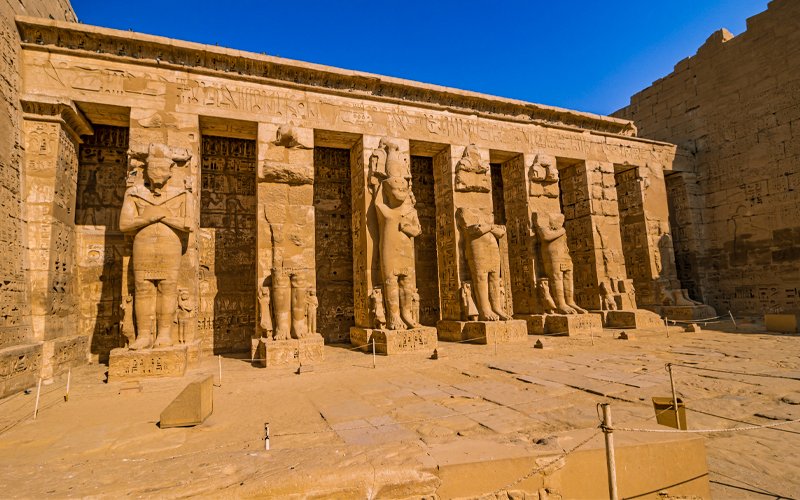A Timeless Tapestry: The Temple of Queen Hatshepsut
Nestled amidst the ancient cliffs of Deir el Bahri, on the western bank of the Nile, the Temple of Hatshepsut stands as a testament to both architectural brilliance and the enduring legacy of a remarkable ruler. This extraordinary monument, carved into the sandstone cliffs, is more than just a physical structure; it is a living narrative of a woman who defied convention and ascended to the pinnacle of power in a world dominated by men. You can visit The Temple of Queen Hatshepsut in the night with our VIP Tour inside the Temple of Queen Hatshepsut. The temple will be yours for 2-Hours
A Queen’s Legacy
Hatshepsut, a visionary leader, dared to challenge the established gender norms of her time. Her reign was characterized by peace, prosperity, and ambitious public works. The temple, designed to commemorate her achievements, is a testament to her unwavering belief in her abilities and determination to leave a lasting mark on history.
The Temple’s Construction and Purpose
-
Construction Period
The temple was built during the reign of Queen Hatshepsut (1479-1458 BCE), a period of prosperity and stability in Egypt.
-
Mortuary Temple:
The temple was primarily designed as a mortuary temple, intended to house Hatshepsut’s mummified body and serve as a place for her spirit to reside in the afterlife.
-
Symbol of Reign:
The temple also served as a symbol of Hatshepsut’s successful reign and her accomplishments. It was a testament to her power and authority.
Stories and Legends of the Temple of Queen Hatshepsut in Deir EL Bahri
The Temple of Queen Hatshepsut, a magnificent monument to the female pharaoh of Egypt, is steeped in history and legend. Here are some of the key stories and themes associated with the temple:
Divine Origins:
The Birth Colonnade depicts Hatshepsut’s divine birth, emphasizing her legitimacy as pharaoh. This story reinforces the idea that the gods chose her to rule.
The Punt Expedition:
The Punt Colonnade celebrates Hatshepsut’s legendary expedition to the distant and mysterious land of Punt. This adventure showcased her adventurous spirit and ability to expand Egypt’s influence.
Architectural Features of the Temple of Queen Hatshepsut
Three-Tiered Structure:
The temple is divided into three terraces, each connected by ramps and stairs. This design creates a sense of progression and grandeur.
Main Sanctuary:
The first and largest terrace houses the main sanctuary, which is the most sacred part of the temple and where Hatshepsut’s body was placed.
Smaller Chapels and Courtyards:
The second terrace contains several smaller chapels and courtyards, offering additional spaces for worship and contemplation.
Peaceful Garden:
The third terrace is a garden, designed to provide a serene setting for Hatshepsut’s spirit to reside. This reflects the Egyptian belief in the afterlife and the importance of a peaceful resting place.
As we stand in the shadow of the Temple of Queen Hatshepsut, we are not merely witnesses to an ancient structure but participants in an unfolding saga of a visionary queen who defied norms and left an indelible mark on history. The Temple of Queen Hatshepsut stands as a testament to the enduring spirit of innovation, unity, and the pursuit of greatness that characterized this remarkable era in ancient Egypt.

Conclusion:
As we stand in the shadow of the Temple of Hatshepsut, we are not merely witnesses to an ancient structure but participants in an unfolding saga of a visionary queen who defied norms and left an indelible mark on history. The Temple of Hatshepsut stands as a testament to the enduring spirit of innovation, unity, and the pursuit of greatness that characterized this remarkable era in ancient Egypt.
Is the Temple of Queen Hatshepsut worth visiting?
Visiting the Temple of Hatshepsut is a must for those intrigued by ancient Egyptian history and architecture. This impressive monument stands as a striking tribute to the pioneering female pharaoh Hatshepsut, demonstrating her immense power and influence. As a female pharaoh, Hatshepsut’s temple provides a unique perspective on ancient Egyptian history, making it a truly unforgettable destination.

